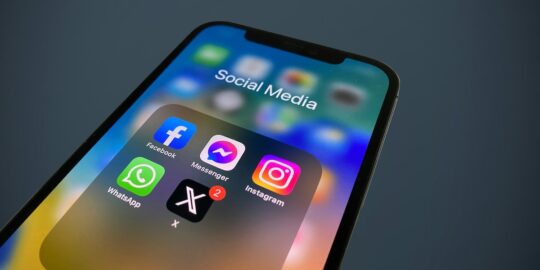
Teachers estimate that screen mirroring solutions can save up to 10 minutes per class – and the benefits don’t end there. It’s no wonder, then, that so many schools are investing in this revolutionary technology – but what’s the best screen mirroring device for your district classrooms?
In this post, we’ll be exploring how every classroom can benefit from a screen mirroring device and offer tips about what features to look for when choosing a solution that will meet the needs of your district. Finally, we’ll recommend what we think is the best choice for the education sector.
Why Your Classroom Needs a Screen Mirroring Device
The best screen mirroring device will enable teachers to connect their phone, tablet, or computer screen wirelessly to the in-classroom display so that they can effortlessly present teaching materials to their class. Here are five reasons why every classroom needs one.
It frees teachers from their desks
Effective teachers are mobile teachers. They don’t hide behind their desks – they move around the classroom, supervising and interacting with students to ensure they’re engaged in the lesson.
But unfortunately, many schools still rely on wired overhead projectors and HDMI cables, which keep teachers tethered to their desks and prevent them from freely moving around the classroom.
The best screen mirroring devices solve this problem. They allow teachers to present lessons to the central classroom display, often a flat-panel TV or interactive flat panel, wirelessly so they can stay mobile and roam around while still engaging with the lesson.
Not only does this give your teachers more control over their lessons, but it can also enhance student engagement and improve learning outcomes.
It makes schools and classrooms safer
Aside from allowing teachers to stay mobile, investing in screen mirroring technology also makes classrooms safer. Long cables running across the floor are trip hazards. Going wireless means teachers can spend less time worrying about accidents in the classroom, and more time focusing on teaching.
The best screen mirroring solutions also allow IT administrators to control hundreds of classroom displays from one centralized location. School leaders can use this feature to quickly distribute emergency notifications to every display and all the digital signage in the school at once if the need were to ever arise.
And of course, using screen mirroring solutions means teachers don’t have to interact physically with their classroom display – they can control what’s being shown on the display from their own device. This reduces ‘touchpoints’ in the classroom, which is more important than ever in the post-pandemic era.
It increases student engagement
The best screen mirroring solutions can increase student engagement by facilitating a fluid, interactive learning environment. EdTech Magazine says, “The ability to quickly engage in interactive conversation with multiple participants is perhaps the biggest benefit of both screen mirroring and screencasting technologies.”
These modern solutions enable teachers to move around the classroom and interact with the display from their devices.
Depending on what screen mirroring solution you choose, students can share their work through the same app (with teacher permission) with the class in order to contribute to the lesson. Allowing students to contribute to the lesson, while the teacher remains in control, can increase student confidence and boost engagement.
Some screen mirroring apps even let multiple students share content to the central display at the same time, so you can compare student work side-by-side.
Your IT technicians will appreciate it
Screen mirroring technology doesn’t just benefit teachers – it also helps reduce your IT technicians’ workload.
Without screen mirroring tech, schools typically have to rely on wired connections like HDMI cables – and wired solutions are prone to issues. IT techs often get called out to classrooms to fix issues with overhead projectors and cables that have gotten tangled or stopped working.
When you switch to wireless screen mirroring tech, this is no longer an issue. It’s a much more reliable, solution that’s less prone to issues, particularly if it’s a screen mirroring solution built specifically for classroom environments. If issues do arise, IT techs no longer have to get called out to classrooms to fix it – they can manage the whole platform from one centralized location.
Your IT techs may even know of any technical issues before the teacher even arrives to class, so they can respond more quickly and efficiently. They can also perform bulk software updates across the school at once, and IT managers can look at built-in metrics to see how much teachers and students are using the software.
It reduces expenditure
It’s estimated that the US spends upwards of $26 billion per year on educational technology. One of the pricier items are interactive flat panels, some of which include a screen mirroring capability. While these high-tech panels provide a wow factor, they aren’t as flexible as some screen mirroring solutions and come at a hefty price tag of $5,000 or more per panel.
The best screen mirroring device allows teachers and students to share work on a central display as well as individual displays groups of four can share in a pod-like arrangement. So, it’s possible for the entire class to participate on one display or work in small groups on shared displays. These devices offer greater flexibility and can cost as little as $150 per year.
Wireless screen mirroring will also reduce the number of cables and adapters used in your display system. This, in turn, can reduce your maintenance costs. And the best screen mirroring devices will be agnostic to other devices, allowing any device a student or teacher may be using to effortlessly connect.
Related: [7 Best Interactive Classroom Technology Tools & How to Use Them Effectively]
It can bring your classroom into the 21st century
Technology has evolved rapidly over the last 10 years – and it continues to evolve every year. Despite this, many districts are still using the same outdated technology to power their classrooms as they did a decade ago.
District IT leaders must keep pace with the evolving technological landscape in order to give students experiences with modern tech and empower teachers to teach the skills that will be essential for students in their future job roles.
Messy cables are relics of the past. And screen mirroring apps made for the masses are riddled with issues when it comes to the classroom. Switching to screen mirroring solutions can help to bring your classroom into the modern era, which is exciting for both teachers and students.
But all isn’t lost when it comes to your existing classroom technology investments. For instance, overhead projectors are still highly effective when paired with a screen mirroring device. And that older flat panel TV? Modernize it with a screen mirroring device.
How to choose the best screen mirroring device
There are many different screen mirroring solutions on the market – but they’re not all equally suitable for classrooms.
In order to find the best screen mirroring device for your district, it’s important to think carefully about the features you’re looking for and weigh up your options before making a decision. Here are some factors to think about.
Look for a low-maintenance solution
When it comes to choosing a screen mirroring solution for your district, it’s a good idea to choose a solution that will be easy for your teachers and students to use, and one that is easy for your IT department to maintain.
Some solutions are created for business purposes, and they can have quite a high learning curve for non-specialists. This is something you want to avoid, as you want to make it easy for IT professionals – or even teachers – to troubleshoot if a problem arises.
Therefore, it’s best to opt for an app-based screen mirroring software that is wireless and can be used right out of the box. Screen mirroring solutions that require a wired connection, or that have to be installed in individual classrooms, can be harder for IT staff to maintain, and they will have to travel to the different classes in order to resolve issues.
With a wireless solution, many issues can also be fixed via the software app, and this will make life easier for everybody and ensure that issues don’t affect class time or distract students.
Consider device compatibility
In most schools, students and teachers have access to a wide variety of devices. In addition to laptops and desktop computers, you may use tablets, Chromebooks, or even mobile phones in the classroom.
It’s important to choose a screen mirroring solution that’s compatible with all the devices you use on a day-to-day basis. Some solutions may only work with desktops or laptops and this isn’t ideal in a school setting, as tablets are quite commonly used by students and teachers alike.
Ideally, you’ll want to choose a solution that any device can connect to. That way, teachers can use it on their mobile phones, tablets, or desktop without having to worry about compatibility issues.
Make sure it supports your classroom display
The screen mirroring solution you choose will depend on what sort of displays the classrooms in your school have. For example, some schools use interactive whiteboards and projectors, whereas some use TVs and flat panel screens. It’s important to ensure that the screen mirroring solution you choose is supported on your chosen displays.
The best way to make sure this is the case is to choose a solution that supports all types of classroom displays. This will give you maximum flexibility and ensure that you can mirror content on any screen in the whole school. You can even use it to present splash screens in dining halls and corridors, not just in the classroom.
Related:[The Ultimate Screen Mirroring Solution Guide for Schools]
Choose a solution that’s purpose-built for education
Some general-purpose screen mirroring solutions aren’t suitable for the education sector. If you plan on using it in the classroom, it’s best to choose a solution designed specifically for academic settings.
These kinds of solutions come with additional features to support and enhance teacher control, student collaboration, and creativity. Some features to look out for in the best screen mirroring devices include:
- Centralized control. Screen mirroring apps that are suitable for schools should be able to be centrally managed by the IT manager or other technology leader.
- Student screenshare previews. Teachers need to remain in control of what’s visible on the classroom display. Therefore, the best screen mirroring devices will be designed for the classroom and allow teachers to preview the content students want to share from their own screens before authorizing it to be presented on the main display.
- Screenshots and annotations. The best screen mirroring devices come with annotation tools that let students screenshot the content teachers share to the display and annotate over it on their own devices. This aids with note-taking and can improve learning outcomes.
There’s only one that’s purpose-built for educators – and that’s Vivi.
Vivi is a plug-and-play, wireless screen mirroring solution designed for use in educational settings. It’s used by over 1,000 schools in over 40,000 classrooms and supports over 250,000 teachers and students.
With Vivi, teachers can present anything to their classroom display via the small Vivi box. It’s compatible with any device, any display, and supports any number of users and classrooms. The solution is super low maintenance and can be managed from one centralized location, making it the go-to choice for busy IT administrators. Want to try it out for yourself? Book a demo today to find out how Vivi can help improve your classroom.



